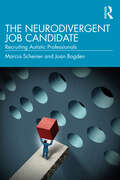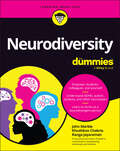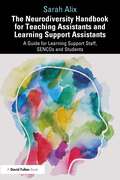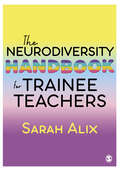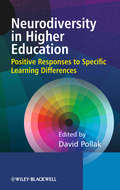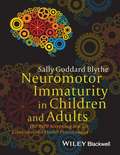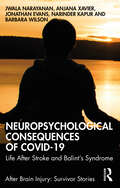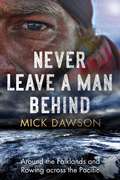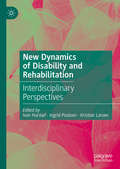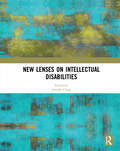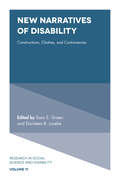- Table View
- List View
The Neurodivergent Job Candidate: Recruiting Autistic Professionals
by Joan Bogden Marcia ScheinerThis book provides guidance on recruiting, interviewing, and onboarding practices that will allow employers to successfully hire neurodivergent professionals into inclusive, competitive employment. Today, 35% of 18-year-olds with an autism spectrum diagnosis attend college, yet they have a 75–85% under-employment and unemployment rate after graduation. While organizations are looking to expand their diversity and inclusion hiring efforts to include neurodivergent professionals, current recruiting and interviewing practices in general are not well-suited to this. With over one-third of the US population identifying as neurodivergent, employers need to address how to attract this talent pool to take advantage of a meaningful segment of the workforce. Readers of this book will gain an understanding of how to guide their organizations through the creation of recruiting, interviewing, and onboarding processes tailored to neurodivergent professionals in any field. Written by authors with extensive experience working in the corporate world and consulting with Fortune 1000 companies on autism hiring efforts, this book is targeted at employers, acknowledging their perspective. Structured as a reference guide for busy recruiters, hiring managers, and supervisors, this book can be read in its entirety, in relevant sections as needed, or used as a refresher whenever necessary. This book also provides a background on the thinking styles of autistic individuals, giving the reader a deeper understanding of how to best support neurodivergent jobseekers.
The Neurodiverse Classroom: A Teacher's Guide to Individual Learning Needs and How to Meet Them
by Victoria HoneybourneWith specific learning difficulties more prevalent than ever in mainstream schools, this is the essential guide for teachers wishing to create inclusive and successful learning environments in diverse classrooms. Focusing on promoting acceptance and self-esteem of each child rather than on labelling their difficulties, it shows how to make good use of simple resources and meet a wide range of needs, including children with ADHD, autism, OCD, dyslexia and special speech and language needs. The practical advice and strategies in this book enable schools to become more accepting places for all pupils, and embrace neurodiversity as the new 'normal' in education today.
Neurodiverse Relationships: Autistic and Neurotypical Partners Share Their Experiences
by Joanna PikeComprised of the accounts of twelve heterosexual couples in which the man is on the Autism Spectrum, this book invites both partners to discuss their own perspectives of different key issues, including anxiety, empathy, employment and socialising. Autism expert Tony Attwood contributes a commentary and a question and answer section for each of the twelve accounts.The first book of its kind to provide perspectives from both sides of a relationship on a variety of different topics, Neurodiverse Relationships is the perfect companion for couples in neurodiverse relationships who are trying to understand one another better.
Neurodiversity and the Twice-Exceptional Student: A Comprehensive Resource for Teachers
by Rhonda FilmerWritten for busy teachers, this practical manual defines terms, shares examples and provides evidence-based information and strategies to support the teaching of twice-exceptional students. Providing a comprehensive blueprint in an easy-to-use format, this book explains classroom techniques for differentiation with tips and advice based on research and teacher experience. The topics covered include learning disabilities, gifted and high potential education, talent development and general classroom pedagogy involving curriculum differentiation and individualised programming. It also explains, in more depth, the varying presentations of neurodiversity in the form of specific learning disabilities, autism and attention deficits in the gifted/high potential student to enable teachers to acquire more knowledge of the nuances evident in each twice-exceptional student. Case studies capture the perspectives of twice-exceptional young people who have thrived, and the book provides weblinks to a very comprehensive list of helpful, freely-available resources.This essential, practical resource will serve teachers and educators in both primary and secondary schooling, as well as pre-service educators. It will also be of interest to parents and carers.
Neurodiversity and the Twice-Exceptional Student: A Comprehensive Resource for Teachers
by Rhonda FilmerWritten for busy teachers, this practical manual defines terms, shares examples and provides evidence-based information and strategies to support the teaching of twice-exceptional students. Providing a comprehensive blueprint in an easy-to-use format, this book explains classroom techniques for differentiation with tips and advice based on research and teacher experience. The topics covered include learning disabilities, gifted and high potential education, talent development and general classroom pedagogy involving curriculum differentiation and individualised programming. It also explains, in more depth, the varying presentations of neurodiversity in the form of specific learning disabilities, autism and attention deficits in the gifted/high potential student to enable teachers to acquire more knowledge of the nuances evident in each twice-exceptional student. Case studies capture the perspectives of twice-exceptional young people who have thrived, and the book provides weblinks to a very comprehensive list of helpful, freely-available resources.This essential, practical resource will serve teachers and educators in both primary and secondary schooling, as well as pre-service educators. It will also be of interest to parents and carers.
Neurodiversity For Dummies
by John Marble Khushboo Chabria Ranga JayaramanA quick and easy way to understand neurodiversity as written by neurodivergent people and our families Neurodiversity For Dummies is your essential guide in understanding neurodivergent conditions like autism, ADHD, dyslexia, and more. This quick and easy guide is perfect for anyone needing to know more about neurodiversity. And that’s all of us—because recent estimates say that 15-20% of the world’s population have some form of neurodivergence. Your life is filled with neurodivergent people that you know and love, whether you realize it yet or not. It’s time to learn to support and include the neurodivergent among us, and to understand how neurodiversity impacts society and the workplace. This is for the neurodivergent person wanting to thrive in life, for parents and caregivers seeking success for their child, and for teachers who are working to make a difference in their students’ lives. Filled with practical advice, Neurodiversity for Dummies also provides a helping hand to service providers, assistance for workplace managers and colleagues, and understanding for family members and friends. Imagine a world where we all understood ourselves better and appreciated more deeply the differences in others. No matter how your own brain thinks, Neurodiversity for Dummies is for you. Check out this jargon-free introduction for an essential overview. Explore the Spectrum of Neurodiversity: Understand in plain language the world of autism, ADHD, dyslexia, and other neurodivergent conditions. Unlock Hidden Talents: Move yourself beyond common myths and misconceptions to discover how neurodiversity actually works. Learn how neurodiversity has always been with us, why society needs neurodivergent traits, and how neurodiversity can be a wellspring of innovation, creativity, and out-of-the-box thinking. Discover Yourself: Whether you are a neurodivergent person or not, learn how to understand your own normalcy, advocate for your needs, and build meaningful connections with those who think and experience the world differently than you. Change the World Around You: Be empowered through simple steps you can take to create inclusive environments for neurodivergent individuals in your school or workplace. Uncover proven strategies that cultivate a culture of acceptance and respect, where the unique perspectives of all individuals are valued and celebrated. We believe in providing parents with better supports, empowering individuals with information, and shaping a world where we are all seen and understood. With an author team composed of neurodivergent individuals and parents writing together, Neurodiversity for Dummies is an example of the power of neurodiversity when put into action. It’s why we wrote this for you. Don’t miss your chance to embark on this transformative journey. Order your copy of Neurodiversity for Dummies now to better understand yourself and others, and to join the movement that is revolutionizing how we understand and support the diversity of the human mind.
Neurodiversity For Dummies
by John Marble Khushboo Chabria Ranga JayaramanA quick and easy way to understand neurodiversity as written by neurodivergent people and our families Neurodiversity For Dummies is your essential guide in understanding neurodivergent conditions like autism, ADHD, dyslexia, and more. This quick and easy guide is perfect for anyone needing to know more about neurodiversity. And that’s all of us—because recent estimates say that 15-20% of the world’s population have some form of neurodivergence. Your life is filled with neurodivergent people that you know and love, whether you realize it yet or not. It’s time to learn to support and include the neurodivergent among us, and to understand how neurodiversity impacts society and the workplace. This is for the neurodivergent person wanting to thrive in life, for parents and caregivers seeking success for their child, and for teachers who are working to make a difference in their students’ lives. Filled with practical advice, Neurodiversity for Dummies also provides a helping hand to service providers, assistance for workplace managers and colleagues, and understanding for family members and friends. Imagine a world where we all understood ourselves better and appreciated more deeply the differences in others. No matter how your own brain thinks, Neurodiversity for Dummies is for you. Check out this jargon-free introduction for an essential overview. Explore the Spectrum of Neurodiversity: Understand in plain language the world of autism, ADHD, dyslexia, and other neurodivergent conditions. Unlock Hidden Talents: Move yourself beyond common myths and misconceptions to discover how neurodiversity actually works. Learn how neurodiversity has always been with us, why society needs neurodivergent traits, and how neurodiversity can be a wellspring of innovation, creativity, and out-of-the-box thinking. Discover Yourself: Whether you are a neurodivergent person or not, learn how to understand your own normalcy, advocate for your needs, and build meaningful connections with those who think and experience the world differently than you. Change the World Around You: Be empowered through simple steps you can take to create inclusive environments for neurodivergent individuals in your school or workplace. Uncover proven strategies that cultivate a culture of acceptance and respect, where the unique perspectives of all individuals are valued and celebrated. We believe in providing parents with better supports, empowering individuals with information, and shaping a world where we are all seen and understood. With an author team composed of neurodivergent individuals and parents writing together, Neurodiversity for Dummies is an example of the power of neurodiversity when put into action. It’s why we wrote this for you. Don’t miss your chance to embark on this transformative journey. Order your copy of Neurodiversity for Dummies now to better understand yourself and others, and to join the movement that is revolutionizing how we understand and support the diversity of the human mind.
The Neurodiversity Handbook for Teaching Assistants and Learning Support Assistants: A Guide for Learning Support Staff, SENCOs and Students
by Sarah AlixThis highly practical book supports the knowledge and development of teaching assistants and learning support assistants (TAs/LSAs) in their understanding of neurodivergent pupils. Considering a neurodivergent world is vital in society today, and even more so in the classroom. Starting with a model of difference rather than deficit and highlighting the complexities involved, this accessible resource focuses on effective strategies to support these pupils and explores the vital role of learning support in a range of different contexts. Rich in pedagogical features, this book includes chapter objectives, areas for the reader to reflect upon, links throughout to the Teaching Assistant Standards and case studies for the reader to examine. Each chapter also has a further reading section which will include links to articles, websites, and organisations that can aid and support the development of TAs and LSAs. This important work will provide Special Educational Needs Co-ordinators (SENCos) with a framework to support their support staff in the classroom.
The Neurodiversity Handbook for Teaching Assistants and Learning Support Assistants: A Guide for Learning Support Staff, SENCOs and Students
by Sarah AlixThis highly practical book supports the knowledge and development of teaching assistants and learning support assistants (TAs/LSAs) in their understanding of neurodivergent pupils. Considering a neurodivergent world is vital in society today, and even more so in the classroom. Starting with a model of difference rather than deficit and highlighting the complexities involved, this accessible resource focuses on effective strategies to support these pupils and explores the vital role of learning support in a range of different contexts. Rich in pedagogical features, this book includes chapter objectives, areas for the reader to reflect upon, links throughout to the Teaching Assistant Standards and case studies for the reader to examine. Each chapter also has a further reading section which will include links to articles, websites, and organisations that can aid and support the development of TAs and LSAs. This important work will provide Special Educational Needs Co-ordinators (SENCos) with a framework to support their support staff in the classroom.
The Neurodiversity Handbook for Trainee Teachers
by Sarah AlixConsidering a neurodivergent world is vital in society today, and even more so in the classroom. This book will support your knowledge and development as a trainee teacher so you can better understand the complexities of working with neurodivergent pupils. Starting with a model of difference rather than deficit, this book will guide trainee teachers to understand neurodiversity within the classroom, providing strategies which aim to support their students. Dr Sarah Alix is Initial Teacher Training Programme Director with the Sigma Trust
The Neurodiversity Handbook for Trainee Teachers
by Sarah AlixConsidering a neurodivergent world is vital in society today, and even more so in the classroom. This book will support your knowledge and development as a trainee teacher so you can better understand the complexities of working with neurodivergent pupils. Starting with a model of difference rather than deficit, this book will guide trainee teachers to understand neurodiversity within the classroom, providing strategies which aim to support their students. Dr Sarah Alix is Initial Teacher Training Programme Director with the Sigma Trust
The Neurodiversity Handbook for Trainee Teachers
by Sarah AlixConsidering a neurodivergent world is vital in society today, and even more so in the classroom. This book will support your knowledge and development as a trainee teacher so you can better understand the complexities of working with neurodivergent pupils. Starting with a model of difference rather than deficit, this book will guide trainee teachers to understand neurodiversity within the classroom, providing strategies which aim to support their students. Dr Sarah Alix is Initial Teacher Training Programme Director with the Sigma Trust
Neurodiversity in Higher Education: Positive Responses to Specific Learning Differences
by David PollakThis edited collection offers screening, teaching and practical support for specific learning differences in Higher Education Uses international case studies to explain how psychologists identify, assess and support a range of specific learning differences in students The higher education sector has come to terms with dyslexia, but todayâ??s students are disclosing a range of learning differences including dyspraxia, ADHD, Aspergerâ??s Syndrome and dyscalculia Institutions in all major Western countries are required by law to avoid disadvantaging students with special educational needs, so staff must be up to date on how to recognise and support them Supported by an already popular website, Brain HE, with extra materials and colour photographs
Neuromotor Immaturity in Children and Adults: The INPP Screening Test for Clinicians and Health Practitioners
by Sally Goddard BlytheAvailable to healthcare professionals for the first time, this book contains proven screening tests to measure neuromotor immaturity in children and adults in order to provide a basis for referral and help. Allows practitioners to screen for disorders of movement that can negatively affect educational performance and emotional function in children and adolescents Assesses instances where disorders of movement in adults are affecting thoughts and behavior, as in panic disorder Provides a novel approach for health care professionals observing aberrant reflexes in the absence of more serious pathology Includes reproducible scoring and observation sheets for practice and serves as the perfect complement to Assessing Neuromotor Readiness for Learning
Neuromotor Immaturity in Children and Adults: The INPP Screening Test for Clinicians and Health Practitioners
by Sally Goddard BlytheAvailable to healthcare professionals for the first time, this book contains proven screening tests to measure neuromotor immaturity in children and adults in order to provide a basis for referral and help. Allows practitioners to screen for disorders of movement that can negatively affect educational performance and emotional function in children and adolescents Assesses instances where disorders of movement in adults are affecting thoughts and behavior, as in panic disorder Provides a novel approach for health care professionals observing aberrant reflexes in the absence of more serious pathology Includes reproducible scoring and observation sheets for practice and serves as the perfect complement to Assessing Neuromotor Readiness for Learning
Neuropsychological Consequences of COVID-19: Life After Stroke and Balint's Syndrome (ISSN)
by Jwala Narayanan Anjana Xavier Jonathan Evans Narinder Kapur Barbara WilsonNeuropsychological Consequences of COVID-19 focuses on Anjana’s journey as a COVID survivor following a brain injury that left her with a very rare neuropsychological syndrome called Balint’s syndrome, a disorder associated with difficulties in visual and spatial coordination. It is also the first book of its kind to provide a first-hand account from India on surviving brain injury, from diagnosis, recovery and rehabilitation, providing the therapeutic milieu in the Indian context and exploring cultural influences on rehabilitation.Written jointly by Anjana, her neuropsychologist and the international experts in the field of neuropsychology who were also involved in her diagnosis and care, the book highlights how COVID-19, a virus primarily affecting the respiratory system, can also result in a disabling brain injury. It describes Anjana’s recovery and the rehabilitation she received and provides a deeper understanding of this experience of a very rare condition through the views of Anjana herself. In addition, Anjana’s rehabilitation journey stumbles upon many important themes of rehabilitation including cultural sensitivity, personal identity, resilience, role of family and rehabilitation in a low to middle income country.This book is valuable reading for clinical and neuropsychologists, neurologists, other rehabilitation therapists including physiotherapists, occupational therapists, nurses and social work professionals, particularly those interested in cross cultural rehabilitation. It will also be of interest to students in these fields.
Neuropsychological Consequences of COVID-19: Life After Stroke and Balint's Syndrome (ISSN)
by Jwala Narayanan Anjana Xavier Jonathan Evans Narinder Kapur Barbara WilsonNeuropsychological Consequences of COVID-19 focuses on Anjana’s journey as a COVID survivor following a brain injury that left her with a very rare neuropsychological syndrome called Balint’s syndrome, a disorder associated with difficulties in visual and spatial coordination. It is also the first book of its kind to provide a first-hand account from India on surviving brain injury, from diagnosis, recovery and rehabilitation, providing the therapeutic milieu in the Indian context and exploring cultural influences on rehabilitation.Written jointly by Anjana, her neuropsychologist and the international experts in the field of neuropsychology who were also involved in her diagnosis and care, the book highlights how COVID-19, a virus primarily affecting the respiratory system, can also result in a disabling brain injury. It describes Anjana’s recovery and the rehabilitation she received and provides a deeper understanding of this experience of a very rare condition through the views of Anjana herself. In addition, Anjana’s rehabilitation journey stumbles upon many important themes of rehabilitation including cultural sensitivity, personal identity, resilience, role of family and rehabilitation in a low to middle income country.This book is valuable reading for clinical and neuropsychologists, neurologists, other rehabilitation therapists including physiotherapists, occupational therapists, nurses and social work professionals, particularly those interested in cross cultural rehabilitation. It will also be of interest to students in these fields.
Never Leave a Man Behind: Around the Falklands and Rowing across the Pacific
by Mick DawsonThe stories of two veterans - one traumatised, one blind - who rediscover themselves with the help of a friend in the course of two epic ocean adventures, kayaking around the Falklands and rowing across the Pacific.Mick Dawson tells the story of kayaking around the Falkland Islands with friend and fellow Royal Marines veteran Steve Grenham, who was struggling to cope with the effects of Post-Traumatic Stress Disorder (PTSD), and the extraordinary tale of his 2,500-mile voyage in a rowing boat with his friend and former Royal Marine Commando Steve 'Sparky' Sparkes, who was not only a rowing novice, but also blind. Sparky and Mick succeeded in rowing across the finish line after a truly epic voyage of over 2,500 miles from Monterey Bay in California to Waikiki, Hawaii. They'd hoped to break the record for a two-man rowboat and finish in less than fifty-five days, but a hurricane interfered with their plans. It took them eighty-two days, sixteen hours and fifty-four minutes to complete the race, but it was an even greater achievement for that, and Sparky became the first visually impaired person to row across the Pacific.The race with Sparky was the second expedition of an organisation Mick had set up a few years earlier, The Cockleshell Endeavour, designed to help another former Royal Marine and friend, Steve Grenham, by kayaking with him around the Falklands, where both former commandos served during the 1982 conflict with Argentina.
New Developments in Autism: The Future is Today
by Sally Wheelwright Manuel CasanovaThis international collection provides a comprehensive overview of cutting-edge research on autism spectrum disorders (ASDs) by well-known experts in the field, stressing the importance of early diagnosis and a good working relationship between parents and professionals.
New Dynamics of Disability and Rehabilitation: Interdisciplinary Perspectives
by Ivan Harsløf Ingrid Poulsen Kristian LarsenThis collection provides a broad coverage of recent changes in medical and vocational rehabilitation in Northern Europe. It presents analyses that cut across health sciences, medical sociology, disability studies and comparative welfare state research. Through this interdisciplinary perspective, the book explores the changing roles of patients, caregivers, professionals and institutions, and the wider implications of these changes for social inequalities in health. What obstacles do different groups of patients encounter when negotiating the complex chains of medical and vocational services? Who decides regarding references to specialized treatments, and the provision of comprehensive and coordinated services, and different types of benefits and material support? What is the importance of the resources that patients and caregivers bring to bear in the rehabilitation process?
New Lenses on Intellectual Disabilities
by Jennifer CleggThis book gathers together recent international research in intellectual disability (ID), examining the diverse modes of existence that characterise living with intellectual disabilities in the 21st century. Ranging from people with no speech and little mobility who need 24-hour care, to people who marry or hold down jobs, this book moves beyond the typical person with ID imagined by public policy: healthy, with mild ID and a supportive family, and living in a welcoming community. The book is divided into three sections. The first, ‘A richer picture of people and relationships’, expands our understanding of different people and lifestyles associated with ID. The second section, ‘Where current policies fall short’, finds that Supported Living provides just as 'mediocre' a form of care as group homes, and concludes that services for people with challenging behaviour are unrelated to need. The contributors’ research identifies no effective employment support strategies, as well as technological and legal changes that prevent organisations from employing people with ID. With nearly a quarter of this population in poor health, the contributors reflect on whether ‘social model’ approaches should be allowed to trump medical considerations. The third section, ‘New thinking about well-being’, reveals that being old, poor, and living alone increases health risk, and that medication administration is significantly more complex for people with ID. Moving beyond 20th century certainties surrounding intellectual disability, this book will be of interest to those studying contemporary issues facing those living with ID, as well as those studying public health policy more widely. The chapters in this book were originally published in issues of the Journal of Intellectual & Developmental Disability.
New Lenses on Intellectual Disabilities
by Jennifer CleggThis book gathers together recent international research in intellectual disability (ID), examining the diverse modes of existence that characterise living with intellectual disabilities in the 21st century. Ranging from people with no speech and little mobility who need 24-hour care, to people who marry or hold down jobs, this book moves beyond the typical person with ID imagined by public policy: healthy, with mild ID and a supportive family, and living in a welcoming community. The book is divided into three sections. The first, ‘A richer picture of people and relationships’, expands our understanding of different people and lifestyles associated with ID. The second section, ‘Where current policies fall short’, finds that Supported Living provides just as 'mediocre' a form of care as group homes, and concludes that services for people with challenging behaviour are unrelated to need. The contributors’ research identifies no effective employment support strategies, as well as technological and legal changes that prevent organisations from employing people with ID. With nearly a quarter of this population in poor health, the contributors reflect on whether ‘social model’ approaches should be allowed to trump medical considerations. The third section, ‘New thinking about well-being’, reveals that being old, poor, and living alone increases health risk, and that medication administration is significantly more complex for people with ID. Moving beyond 20th century certainties surrounding intellectual disability, this book will be of interest to those studying contemporary issues facing those living with ID, as well as those studying public health policy more widely. The chapters in this book were originally published in issues of the Journal of Intellectual & Developmental Disability.
New Narratives of Disability: Constructions, Clashes, and Controversies (Research in Social Science and Disability #11)
by Sara E. Green Donileen R. LosekeThis volume explores questions about narrative frameworks in disability research. Narrative is a omnipresent meaning-producing communication form in social life that is both cultural and personal. Public understandings of disability tend to follow a medical storyline in which disability is a personal tragedy to be treated through professional intervention - a frame that disempowers and fails to resonate with many disabled people. Scholars in disability studies and the social sciences have proposed an alternative that portrays social structures, forces, and attitudes as the problems to be resolved - a frame that, while empowering, may neglect, or even repress, some kinds of personal disability stories. This volume seeks to answer the call for richer, more diverse understandings of disability. We explore how narrative inquiry can broaden perspectives on disability to include pain, suffering, chronic illness, and episodic disability, as well as the perspectives of family members and caregivers, while also serving as a platform for dismantling prejudice and discrimination in order to promote positive social change.
New Narratives of Disability: Constructions, Clashes, and Controversies (Research in Social Science and Disability #11)
by Sara E. Green Donileen R. LosekeThis volume explores questions about narrative frameworks in disability research. Narrative is a omnipresent meaning-producing communication form in social life that is both cultural and personal. Public understandings of disability tend to follow a medical storyline in which disability is a personal tragedy to be treated through professional intervention - a frame that disempowers and fails to resonate with many disabled people. Scholars in disability studies and the social sciences have proposed an alternative that portrays social structures, forces, and attitudes as the problems to be resolved - a frame that, while empowering, may neglect, or even repress, some kinds of personal disability stories. This volume seeks to answer the call for richer, more diverse understandings of disability. We explore how narrative inquiry can broaden perspectives on disability to include pain, suffering, chronic illness, and episodic disability, as well as the perspectives of family members and caregivers, while also serving as a platform for dismantling prejudice and discrimination in order to promote positive social change.
The New nasen A-Z of Reading Resources (nasen spotlight)
by Suzanne Baker Lorraine PetersenThe New nasen A-Z of Reading Resources is a graded list of all current reading schemes complete with guidance on the books’ suitability for readers at different levels of experience and competence. It will: enable teachers, SENCos and support services to choose books that are appropriate yet sufficiently rewarding for struggling readers prove to be a time-saving resource for schools replenishing their reading stock follow up-to-the-minute thinking on ‘readability’. A great resource for all schools - primary and secondary - as well as support services, advisers and literacy consultants.
